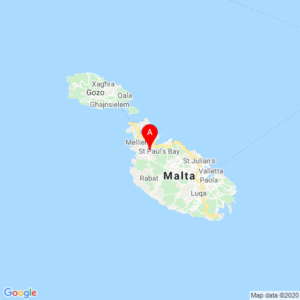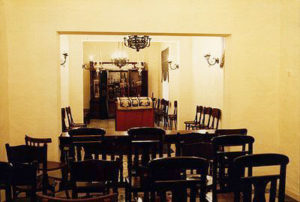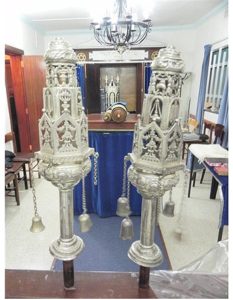 The Jewish population of Malta peaked in the Middle Ages under Norman rule. The Normans occupied the islands from 1091, with five hundred Jews living on the main island and 350 on the sister island, Gozo. The Jewish people generally prospered during this period and were not required to live in ghettos. In 1492 Edict of Expulsion forced all Jews to leave the country. In 1530 Charles V of Spain gave Malta to the Knights of Saint John. The Knights ruled the island until 1798.
The Jewish population of Malta peaked in the Middle Ages under Norman rule. The Normans occupied the islands from 1091, with five hundred Jews living on the main island and 350 on the sister island, Gozo. The Jewish people generally prospered during this period and were not required to live in ghettos. In 1492 Edict of Expulsion forced all Jews to leave the country. In 1530 Charles V of Spain gave Malta to the Knights of Saint John. The Knights ruled the island until 1798.
The Knights would often take passengers of merchant ships, including numerous Jews hostage. There were many Jewish slaves in Malta during this period and Malta was frequently mentioned for its large enslaved Jewish population. Free Jews wishing to visit the country could only enter through one port in Valletta, which is still known as the Jews’ Sally Port. They were required to stay overnight in prisons during their stay. The Jews’ Sally Port still stands in the capital city of Valletta; a bar nearby is called Jews Sally Port, and its logo is an Orthodox-looking man.
 What ultimately freed all Jews was the arrival of Napoleon in 1798. During the two-year French rule from 1798 to 1800 and subsequent British rule until 1964, when Malta became independent, Jews came from Gibraltar, England, North Africa, Portugal, and Turkey.
What ultimately freed all Jews was the arrival of Napoleon in 1798. During the two-year French rule from 1798 to 1800 and subsequent British rule until 1964, when Malta became independent, Jews came from Gibraltar, England, North Africa, Portugal, and Turkey.
During the early 20th century, the island did not always have a rabbi of its own and rabbis would be flown in from Sicily to perform ceremonies. In the time before World War II many Jews fleeing Nazism came to Malta as it was the only European country not to require visas of Jews fleeing German rule. Consequently, Malta rescued thousands of Jews from persecution. Numerous Maltese Jews or Jews arrived in Malta, and many fought the Nazi regime in the British Army during the war.
 In more recent times, the community found itself without a synagogue when the old synagogue in Valletta was demolished as part of a slum clearance scheme in 1979. The cemetery at Tal-Braxja is overgrown with weeds and sorely neglected. But, there are signs of renewal. In the Maltese town of Ta’Xbiex (tash-BEESH), a second-floor apartment in an aging residential building named “Florida Mansions” has functioned for 20 years as a makeshift synagogue.Yet hidden in the wooden ark of this unassuming little shul is a remarkable treasure: seven Torah scrolls, including one inscribed on goatskin parchment, brought to Malta from Tripoli by Libyan Jews nearly two centuries ago.
In more recent times, the community found itself without a synagogue when the old synagogue in Valletta was demolished as part of a slum clearance scheme in 1979. The cemetery at Tal-Braxja is overgrown with weeds and sorely neglected. But, there are signs of renewal. In the Maltese town of Ta’Xbiex (tash-BEESH), a second-floor apartment in an aging residential building named “Florida Mansions” has functioned for 20 years as a makeshift synagogue.Yet hidden in the wooden ark of this unassuming little shul is a remarkable treasure: seven Torah scrolls, including one inscribed on goatskin parchment, brought to Malta from Tripoli by Libyan Jews nearly two centuries ago.
 The community boasts of three Jewish cemeteries in Malta. The oldest, that of Kalkara, goes back to the XVIII century. Then next door to the ” Turkish cemetery ” with a very ornamental entrance, the small current Jewish cemetery, in the suburbs of Marsa, which dates from the middle of the last century. The third is the neglected cemetery at Tal-Braxja overgrown by grass, is found desecrated by unscrupulous builders and MSU employees who dump empty Pepsi bottles and other garbage on top of this sacred ground.
The community boasts of three Jewish cemeteries in Malta. The oldest, that of Kalkara, goes back to the XVIII century. Then next door to the ” Turkish cemetery ” with a very ornamental entrance, the small current Jewish cemetery, in the suburbs of Marsa, which dates from the middle of the last century. The third is the neglected cemetery at Tal-Braxja overgrown by grass, is found desecrated by unscrupulous builders and MSU employees who dump empty Pepsi bottles and other garbage on top of this sacred ground.
Despite a rich Jewish history that predates even the Roman Empire, this Mediterranean tourist paradise is today home to no more than 200 Jews. All live on the main island of Malta, with none left on Malta’s smaller sister island, Gozo, or on tiny Comino, which today is virtually uninhabited.